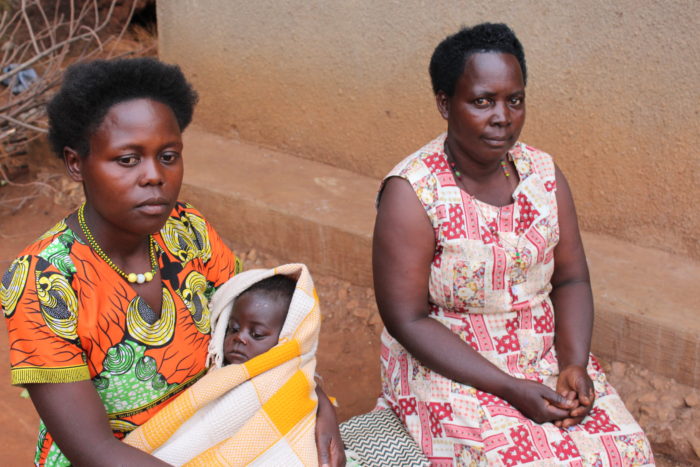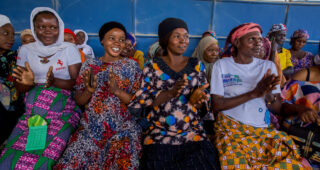Averting a Breastfeeding Crisis Amidst COVID-19
Scovia Twongeirwe, 29, is no novice to breastfeeding, but as the world was reeling with a new pandemic this year, she found herself unable to feed her newborn son and worried that she would lose him.
While Scovia has had two healthy pregnancies, she has also lost two babies during childbirth. For baby number five, Scovia hoped for the best as she faithfully attended antenatal care at the Rubindi Health Centre III in southwest Uganda, where she planned to deliver her baby.

When labor started in mid-January, Scovia’s midwife detected that Scovia needed more specialized care and rushed her to Bwizibwera Health Centre IV, a higher-grade facility. After a difficult labor Scovia underwent an emergency caesarean section, and she gave birth to a healthy baby boy weighing 3.2 kilograms (7 pounds).
Scovia lost a lot of blood during the procedure and was in and out of consciousness for two days. Her mother-in-law, Mbabazi Grace, never left her side and took care of the baby along with the health workers. When Scovia regained consciousness, she was overjoyed that her baby boy was alive.
Breastfeeding became the next challenge.
“I did not know how she could breastfeed since the baby was not started on breastfeeding when he was born,” says Mbabazi. “But the midwives kept encouraging us that the breastmilk was there and would come.”
“The midwives kept encouraging us that the breastmilk was there and would come.”
“I tried to breastfeed, but nothing was coming,” says Scovia. “My breasts got wounds that were very painful. We decided to start millet porridge with milk, but he never got satisfied. The baby was not putting on weight.”
And then the COVID-19 lockdown started.
“My mother-in-law thought that the baby was not doing well,” said Scovia. “Then he got cough and a fever. We had to go to the health center.”
At Rubindi Health Centre III, the tuberculosis (TB) linkage facilitator on duty, noticed a baby crying and coughing at the immunization service point. Scovia told the linkage facilitator that her baby cried because he hated drinking cold porridge and milk. The linkage facilitator helped warm the porridge and Scovia fed him again. He calmed down for a while.
The linkage facilitator conducted a nutrition assessment as well as a TB screening. The baby was diagnosed with severe acute malnutrition and a bacterial infection.
The clinical officer at the health center was worried because she couldn’t give a 3-month-old therapeutic food to treat malnutrition. She thought about transferring the family again to the referral hospital, but COVID-19 travel restrictions made it difficult to find transport.
She thought about transferring the family again to the referral hospital, but COVID-19 travel restrictions made it difficult to find transport.
So she telephoned Sunday Atwine, the USAID RHITES-SW1 family health program officer. Before COVID-19 the project officer would have had the chance to meet with Scovia face to face. But under the threat of the pandemic, they decided to manage the case over the phone. Together they charted a plan to manage the baby according to the Integrated Management of Acute Malnutrition guidelines.
“We talked in detail about the genesis of the malnutrition and concluded a large part of it was because breastfeeding had stopped, and replacement feeding was not done appropriately, said Sunday. “We validated Scovia’s painful experience and the family’s effort to help the baby. They had been through a lot of anguish.”
The baby was rehydrated, given antibiotics to treat an infection; HIV, TB, and malaria were ruled out. The clinician offered simple but detailed maternal nutrition counseling for Scovia and her mother in law. This was to make sure Scovia was supported to eat healthy food and that efforts to restart breastfeeding would not be sabotaged.
Scovia had struggled with correct positioning and attachment during breastfeeding, which led to the wounds on her breasts. When the clinician reintroduced the possibility of breastfeeding, Mbabazi and Scovia were skeptical but willing to try again. Much to their surprise through using the right position during feeding, the baby attached properly, and the milk came. Scovia was overjoyed and Mbabazi was dumbfounded, her beliefs challenged for the better.
Scovia was overjoyed and Mbabazi was dumbfounded, her beliefs challenged for the better.
On July 16 the baby reached the age of 6 months, and Scovia named him Vincent after his father. He weighed in at 5.6 kilograms (12.3 pounds) and is healthier than ever—even sitting up without any support.
Scovia has since learned about complementary feeding using locally available nutritious foods. Vincent will also be given an additional boost of therapeutic foods to speed up his healing.
1USAID Regional Health Integration to Enhance Services in South West Uganda (USAID RHITES-SW)
USAID RHITES-SW is implemented by the Elizabeth Glaser Pediatric AIDS Foundation.
Amanda Thompson Agaba
Uganda
COVID-19; Maternal & Child Health



